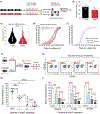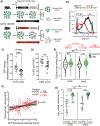Inflammatory exposure drives long-lived impairment of hematopoietic stem cell self-renewal activity and accelerated aging
- PMID: 35858618
- PMCID: PMC9357150
- DOI: 10.1016/j.stem.2022.06.012
Inflammatory exposure drives long-lived impairment of hematopoietic stem cell self-renewal activity and accelerated aging
Abstract
Hematopoietic stem cells (HSCs) mediate regeneration of the hematopoietic system following injury, such as following infection or inflammation. These challenges impair HSC function, but whether this functional impairment extends beyond the duration of inflammatory exposure is unknown. Unexpectedly, we observed an irreversible depletion of functional HSCs following challenge with inflammation or bacterial infection, with no evidence of any recovery up to 1 year afterward. HSCs from challenged mice demonstrated multiple cellular and molecular features of accelerated aging and developed clinically relevant blood and bone marrow phenotypes not normally observed in aged laboratory mice but commonly seen in elderly humans. In vivo HSC self-renewal divisions were absent or extremely rare during both challenge and recovery periods. The progressive, irreversible attrition of HSC function demonstrates that temporally discrete inflammatory events elicit a cumulative inhibitory effect on HSCs. This work positions early/mid-life inflammation as a mediator of lifelong defects in tissue maintenance and regeneration.
Keywords: HSCs; accelerated aging; aging; clonal hematopoiesis; hematopoietic stem cells; inflammaging; inflammation; self-renewal; stem cell exhaustion; stress hematopoiesis.
Copyright © 2022 Elsevier Inc. All rights reserved.
Conflict of interest statement
Declaration of interests The authors declare no competing interests.
Figures




Comment in
-
Turning the clock forward: Inflammation accelerates the aging of hematopoietic stem cells.Cell Stem Cell. 2022 Aug 4;29(8):1156-1158. doi: 10.1016/j.stem.2022.07.002. Cell Stem Cell. 2022. PMID: 35931026 Free PMC article.
References
-
- Angerer P, Haghverdi L, Buttner M, Theis FJ, Marr C, and Buettner F (2016). destiny: diffusion maps for large-scale single-cell data in R. Bioinformatics 32, 1241–1243. - PubMed
-
- Beerman I, Bock C, Garrison BS, Smith ZD, Gu H, Meissner A, and Rossi DJ (2013). Proliferation-dependent alterations of the DNA methylation landscape underlie hematopoietic stem cell aging. Cell Stem Cell 12, 413–425. - PubMed
Publication types
MeSH terms
Grants and funding
LinkOut - more resources
Full Text Sources
Other Literature Sources
Medical
Molecular Biology Databases

